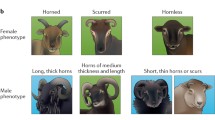Abstract
Sexual conflict occurs because males are selected to produce as many offspring as possible, even if this means lowering the overall reproductive output of individual females. A new model proposed by Gavrilets1 suggests that strong asymmetries between males and females in the costs and benefits of mating will create runaway coevolution between the sexes, promoting rapid divergence between populations and hence speciation. This is an intriguing possibility, not least because it runs counter to existing models2 which suggest that greater sexual conflict will result in males mating more indiscriminately, breaking down reproductive barriers between divergent populations. One reason for this difference is that the new model is based on the idea that females can avoid costs of mating if they are incompatible with some males, whereas we suggest that in reality this may rarely be the case.
Similar content being viewed by others
References
Gavrilets, S. Nature 403, 886–889 ( 2000).
Parker, G. A. & Partridge, L. Phil. Trans. R. Soc. Lond. B 353, 261–274 (1998).
Arnqvist, G. & Nilson, T. Anim. Behav. (in the press).
Holland, B. & Rice, W. R. Proc. Natl Acad. Sci. USA 96, 5083–5088 (1999).
Author information
Authors and Affiliations
Corresponding author
Rights and permissions
About this article
Cite this article
Tregenza, T., Butlin, R. & Wedell, N. Sexual conflict and speciation. Nature 407, 149–150 (2000). https://doi.org/10.1038/35025138
Issue Date:
DOI: https://doi.org/10.1038/35025138
- Springer Nature Limited
This article is cited by
-
The evolution of reproductive isolation through sexual conflict
Nature (2003)
-
Postcopulatory sexual selection
Nature Reviews Genetics (2002)





